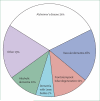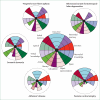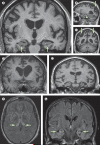The diagnosis of young-onset dementia
- PMID: 20650401
- PMCID: PMC2947856
- DOI: 10.1016/S1474-4422(10)70159-9
The diagnosis of young-onset dementia
Abstract
A diagnosis of dementia is devastating at any age but diagnosis in younger patients presents a particular challenge. The differential diagnosis is broad as late presentation of metabolic disease is common and the burden of inherited dementia is higher in these patients than in patients with late-onset dementia. The presentation of the common degenerative diseases of late life, such as Alzheimer's disease, can be different when presenting in the fifth or sixth decade. Moreover, many of the young-onset dementias are treatable. The identification of causative genes for many of the inherited degenerative dementias has led to an understanding of the molecular pathology, which is also applicable to later-onset sporadic disease. This understanding offers the potential for future treatments to be tailored to a specific diagnosis of both young-onset and late-onset dementia.
Copyright 2010 Elsevier Ltd. All rights reserved.
Figures




References
-
- American Psychiatric Association . Diagnostic and Statistical Manual of Mental Disorders. 4th edn. American Psychiatric Association; Washington DC, USA: 2000. text revision (DSM-IV-TR).
-
- McKhann G, Drachman D, Folstein M, Katzman R, Price D, Stadlan EM. Clinical diagnosis of Alzheimer's disease: report of the NINCDS-ADRDA Work Group under the auspices of Department of Health and Human Services Task Force on Alzheimer's Disease. Neurology. 1984;34:939–44. - PubMed
-
- Petersen RC, Smith GE, Waring SC, Ivnik RJ, Tangalos EG, Kokmen E. Mild cognitive impairment: clinical characteristics and outcome. Arch Neurol. 1999;56:303–08. - PubMed
-
- Dubois B, Feldman H, Jacova C, et al. Research criteria for the diagnosis of alzheimer's disease: revising the NINCDS-ADRDA criteria. Lancet Neurol. 2007;6:734–46. - PubMed
-
- Gauthier S, Reisberg B, Zaudig M, et al. International Psychogeriatric Association Expert Conference on mild cognitive impairment. Mild cognitive impairment. Lancet. 2006;367:1262–70. - PubMed
Publication types
MeSH terms
Grants and funding
LinkOut - more resources
Full Text Sources
Other Literature Sources
Medical

